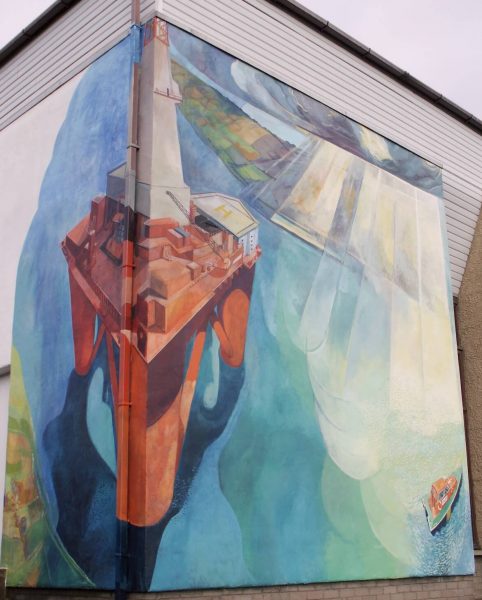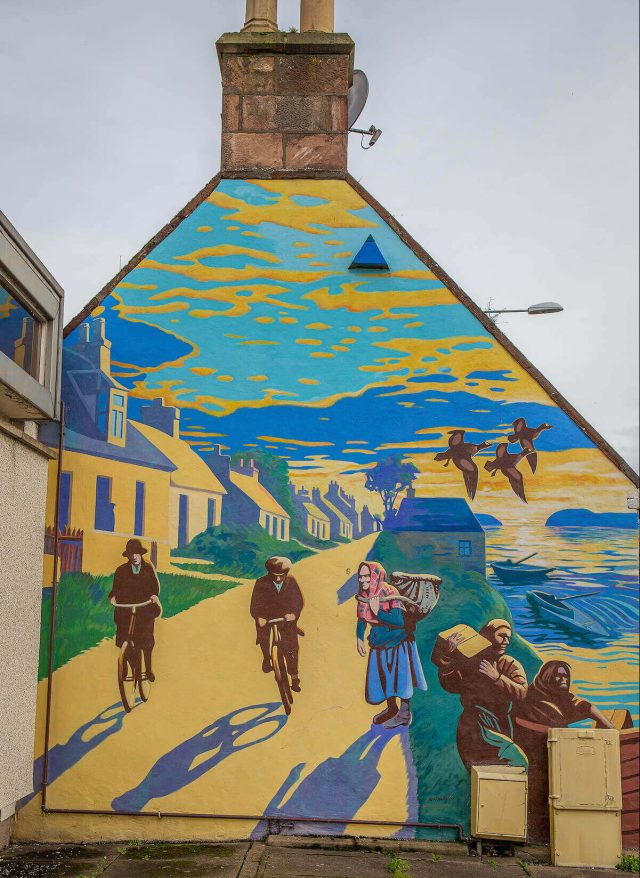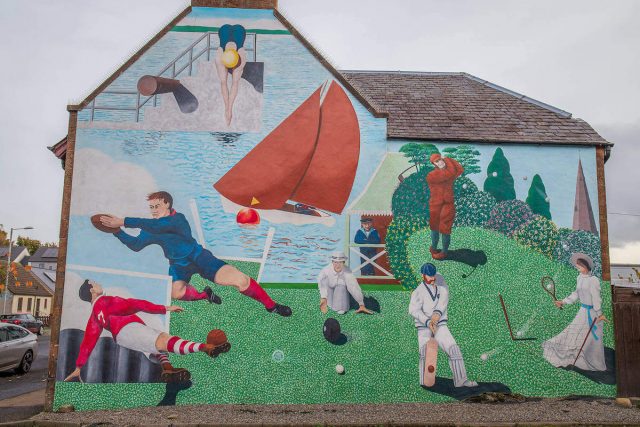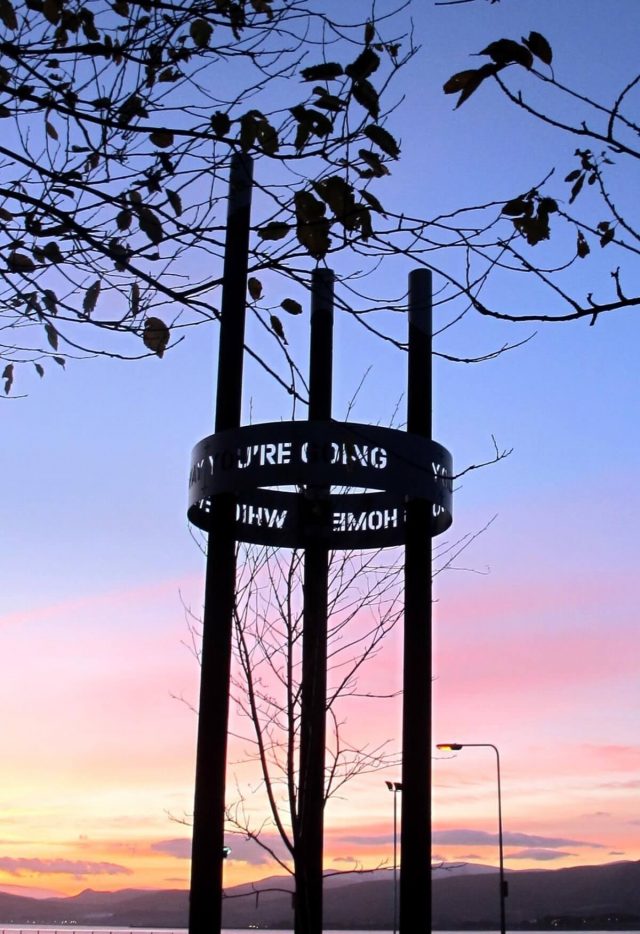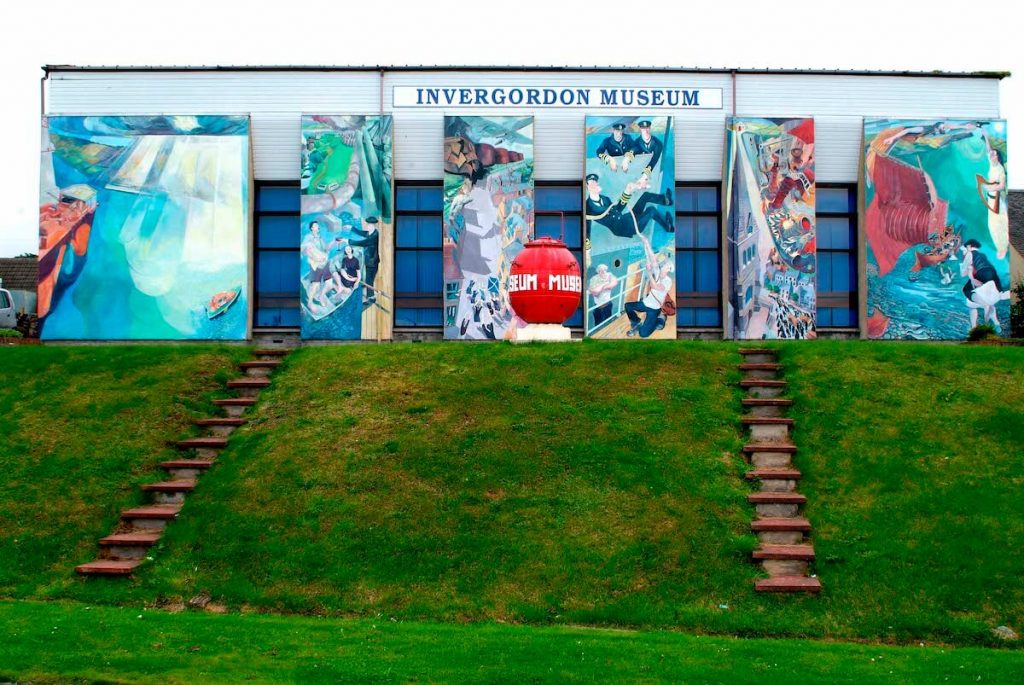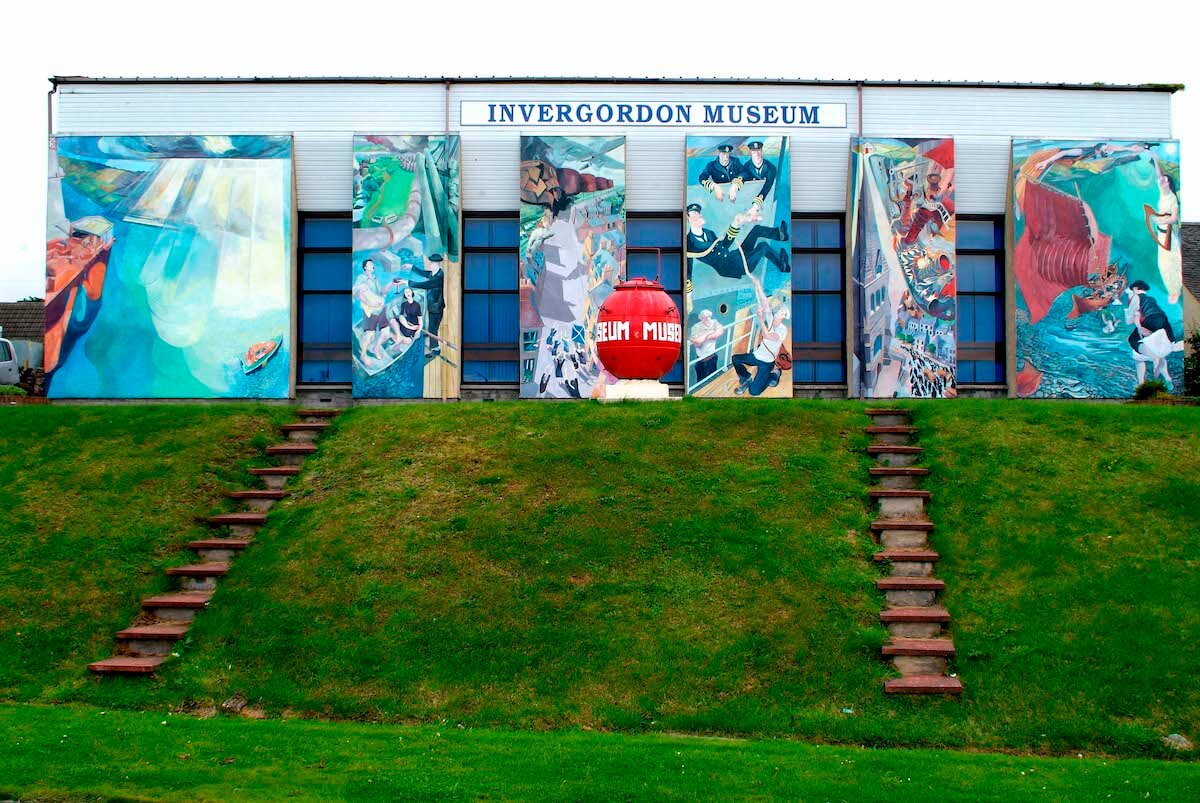
The Heritage of the Firth
by Steve Des Landes (2006)
in consultation with the Invergordon Museum volunteers
The Cromarty Firth’s importance in providing work opportunities for local people, and the fascinating Naval and maritime history of Invergordon led to six mural panels being created. They tell the stories of different aspects of this heritage.
The Heritage of the Firth was the second most popular mural theme voted for by the local community.
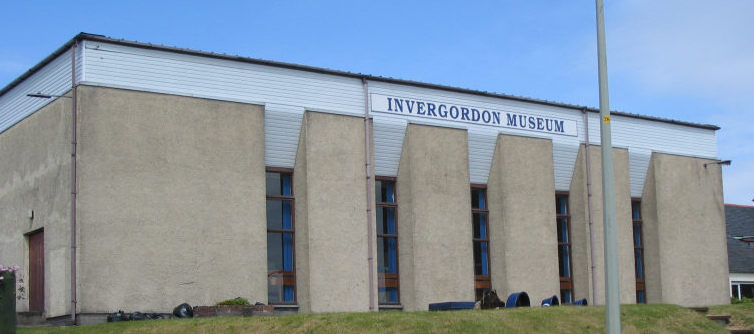
“Enter Steve des Landes with his quirky perspectives and bold colour to convert these grey walls …to a museum that reflects the history of the port both outside and inside.
He was the only artist who painted free hand, everyone else pencilled up blocks, and yet they came out very accurately to the maquette.”
Marion Rhind, founder and former Vice Chair of Invergordon Off the Wall
The Tide Waders
There are several elements to this mural. The foreground shows the tough women who carried their men to the boat ensuring they got there with dry feet.
In the background, Steve explores the two stories of the Sutors (the headlands either side of the entrance to the Cromarty Firth). Sutor means cobbler hence the flying last shared between two giants. And there is also a story of two lovers reaching out to each other across the Firth. Fertility is symbolised in the sheaf of corn.

The Tide Waders
“I think this is a comic event and brought a smile to my face when I was researching it. The women, fishermen’s wives, used to supplement their income by taking out and bringing to shore travellers who wanted to visit the Cromarty Firth. Their purple blue feet accentuate the cold; what tough women they were.
The two figures aloft are the lovers guarding the entrance to the firth, reaching out for one another. His clothing becomes a boat’s hull and the bag around his neck is full of corn, representing the fertile Black Isle.”
Steve Des Landes, 2006
Steve painting ‘The Tide Waders’
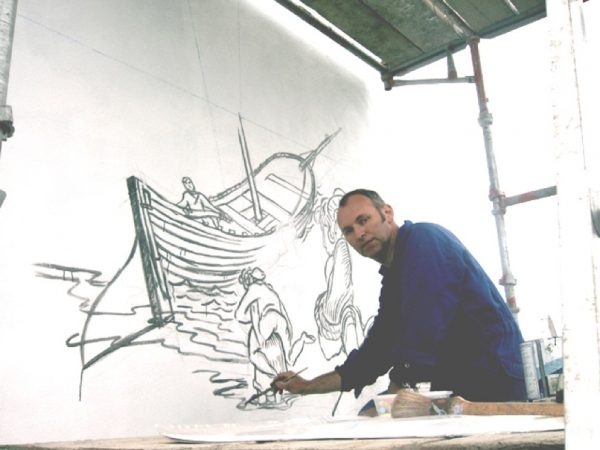
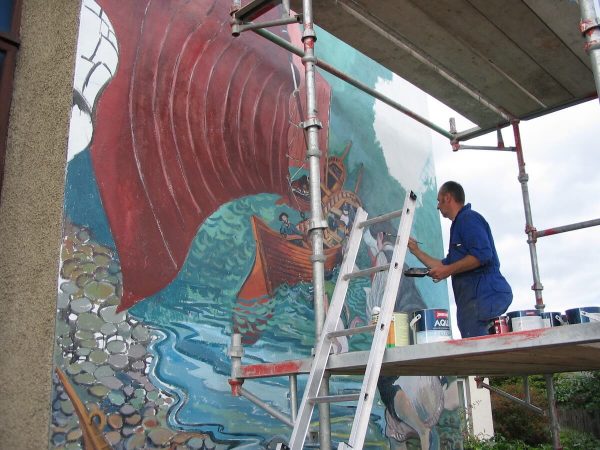
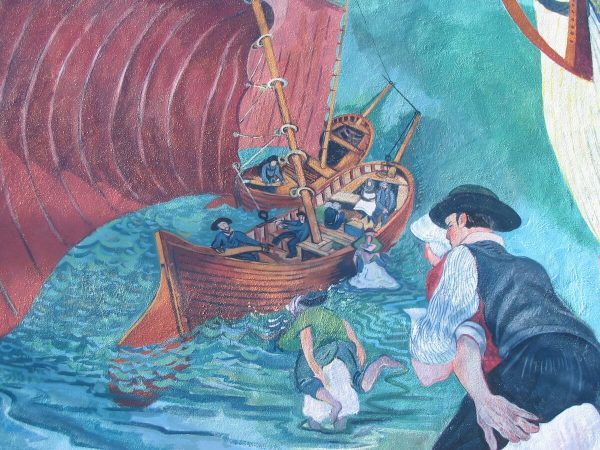
The Sinking of HMS Natal
The Sinking of HMS Natal aligns the boat and the church displaying local grief in the Lowry like figures at the foot of the mural.
The Invergordon community created the Natal Gardens in the centre of town as a memorial to the 421 sailors, civilians and children who died on board HMS Natal when it sank in the Cromarty Firth on the 30th December 1915.
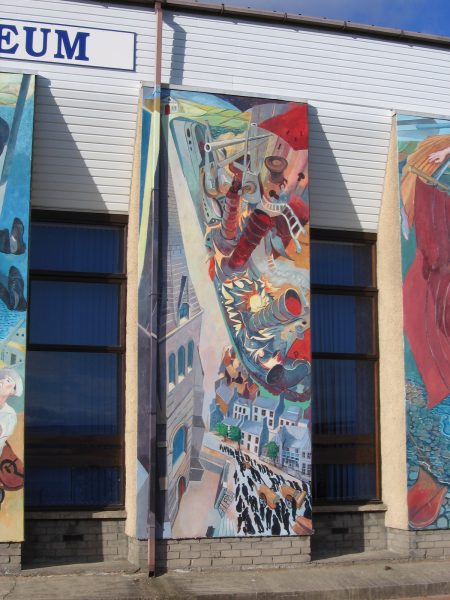
Painting in progress

“I wanted to take a new perspective of this well documented disaster, and create an image of a town overpowered by the event, with the exploding ship’s hull and armaments raining down upon the town. I split the composition between the Church of Scotland and the exploding ship to create a tension and maximise the sense of a ship being a floating community.
The figures at the bottom of the composition are making their way up to the old Naval church, bathed in cold acid light.”
Steve Des Landes, 2006
-
The story of HMS Natal
HMS Natal was a ‘Warrior Class’ cruiser, launched at Barrow in Furness on 30th September 1905. In 1914 she joined the Second Cruiser Squadron, which by 1915 was based in the Cromarty Firth, in the north of Scotland.
The Natal had arrived in the Cromarty Firth the week before Christmas under the command of Captain Eric Back and was enjoying some respite from duty in the North Sea, anchored between Cromarty and Invergordon. As a treat for some locals a film show was organised for the afternoon of 30th December and earlier that day a party of guests including QARNNS nurses, and some civilians including children had also arrived on board.
At twenty past three in the afternoon there was a huge explosion on board followed by several lesser internal explosions and a fire began to rage below. The Natal slowly keeled over to port while some members of her company escaped into the water but within five minutes the Natal had completely capsized.
There was a terrific loss of life with many killed in the explosion and many more were drowned as the ship sunk, or died of exposure in the freezing winter waters of the Cromarty Firth. 421 lives were lost. The site has since been recognised as an official war grave and a buoy still marks the spot where she sank. A few of those who died on the Natal are buried in cemeteries at Rosskeen and Cromarty.
The Invergordon Mutiny – from sketch to mural
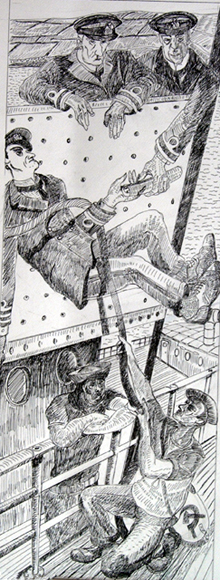
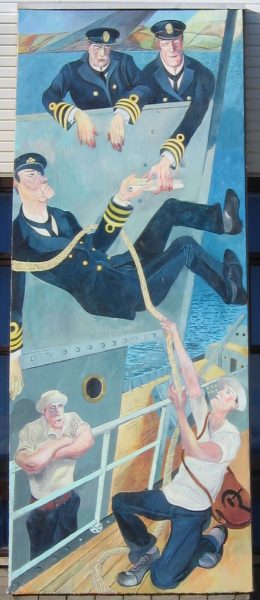
The Invergordon Mutiny was an industrial action by around 1,000 sailors in the Atlantic Fleet that took place on 15–16 September 1931. For two days, ships of the Royal Navy were in open mutiny in one of the few military strikes in British history.
The mutiny caused a panic on the London Stock Exchange and a run on the pound, bringing Britain’s economic troubles to a head and forcing it off the Gold Standard on 21 September 1931.
The Invergordon Mutiny
“Admiral Thompson was the fall guy in this event which is unprecedented in naval history. He took the blame for the lack of discipline that enabled communist sympathiser Len Wincott, who is depicted pulling on the rope, to voice the naval ratings disquiet at receiving a cut in pay.
The figures at the top of the picture with blood on their hands look down scornfully, allowing Admiral Thompson to take the blame in spite of his careful and diplomatic handling of the situation.”
Steve Des Landes, 2006
Tank 13
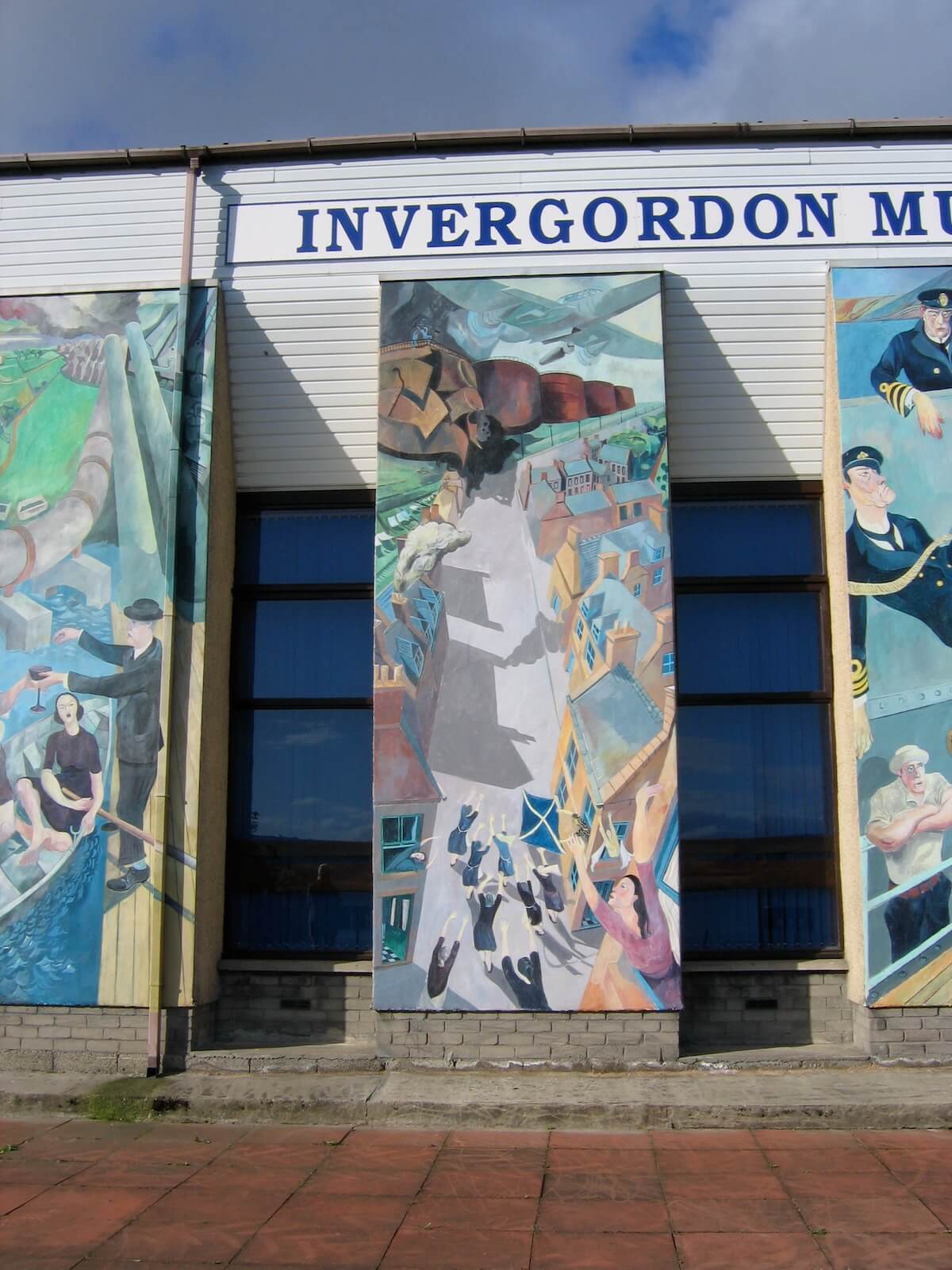
Tank 13
“I wanted to express pictorially this event from the experience of one person and her description of events. From her hairdressing salon she heard the low rumbling sound of a lone aircraft. She came running from her shop, followed by all her clients, still with their heads wrapped in towels, to see the tank erupt and leak oil all the way down the railway line.”
Steve Des Landes, 2006
-
The story of the bombing of Tank 13
On February 15, 1941 a Junkers 88 is reported to have carried out a solo attack on the Seabank tank farm. Approaching from the east at only 40 feet it dropped two 500-pound bombs. The first bomb passed through one tank and into the next. Although it exploded it failed to start a fire, but tons of oil spilled out on to the adjacent railway tracks and nearby station. The second bomb also passed, went through another tank, but failed to explode after landing in the oil slick. The aircraft then made a sharp turn to avoid a church steeple, and machine gunned a Sunderland moored in the firth, causing slight damage, before making its escape. The attack had lasted four minutes, and was over before the defences had reacted. Two civilian workmen had been on top of one of the tanks when the attack began, but managed to slide down to safety – one is said to have headed home, while the other sought refuge in the nearest pub. Stories regarding detonation of the bombs conflict, however it is clear that there was no fire. Tank 13 was completely destroyed in the attack though, and the resultant gap remains on the site as evidence. Only one casualty appears to have been reported – the local bin-man’s horse, said to have died as a result of the heavy fuel oil contaminating its hooves.
Download our app
Why not download the location-aware Invergordon Off the Wall app to help you find the murals, unlock interactive features and learn even more about them during your visit to Invergordon.
The Poisoned Chalice
This refers to the impact on the town of the aluminium smelter and to the short lived industrial promise of prosperity made to the town. The figure balancing precariously in an aluminium boat is uncertain and off balance.
The empty fields in the background refer to the cattle which were affected by brittle bone disease from the fluorine emissions at the smelter.
The Poisoned Chalice
“The town was promised a level of employment with the introduction of the aluminium smelter that it could have hardly dreamed of. The shift away from the land and sea as sources of income, as depicted by the farm, and taking up industrial jobs was short lived. The smelter closed in 1981 with the loss of all jobs. I wanted to portray the sense of betrayal and the false promises that had ensued with the Smelter being sited at Invergordon.
The figure in the suit represents the South mouther bringing money, wealth and prestige. The figure balancing precariously in the aluminium boat is uncertain and off balance; what might he expect with this chalice that is being handed to him?
All the symbols in the picture relate to the terrible sense of betrayal the town experienced.”
Steve Des Landes, 2006
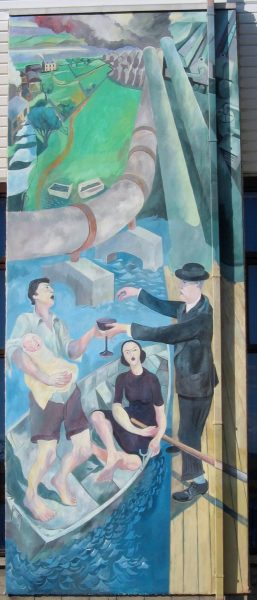
The Oil Rig
“I wanted to portray the rig as if it was a cathedral towering out from the sea with a big dramatic sky which dwarfs all. This panel is a full stop and compliments the first panel of the two sutors and the gulf of life between them, which has been Invergordon’s history.”
Steve Des Landes, 2006
